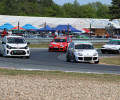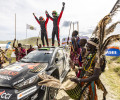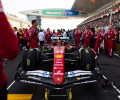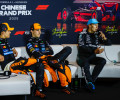From Auto #14: Jackie Stewart
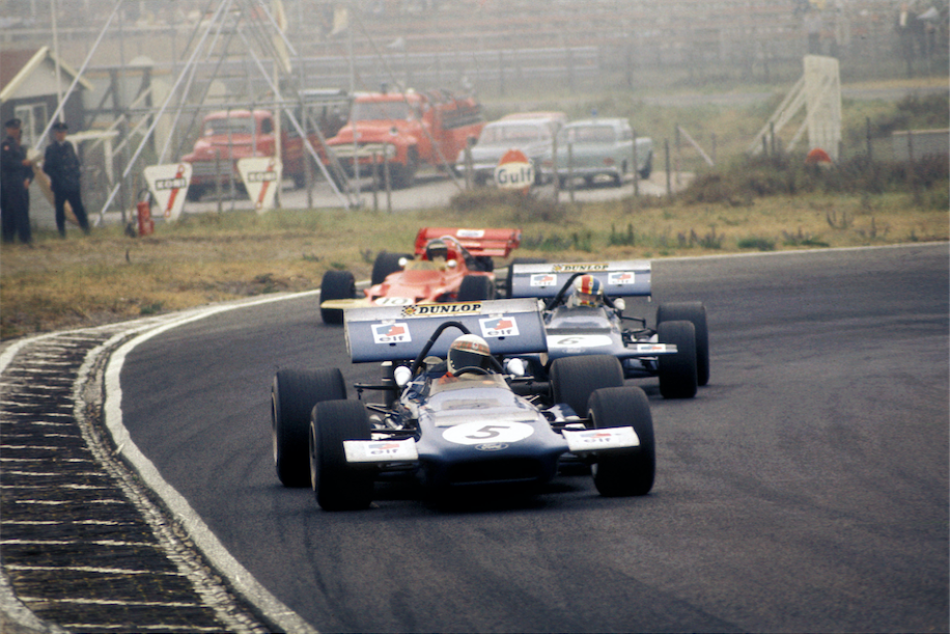
What a noise he made. Three Formula One world titles, 27 grand prix wins – for 14 years the holder of the sport’s record for most victories – F1 safety evangelist; team boss; icon; legend. And happily, too, still with us at 76, a livestream to a di erent time and place in grand prix motor racing; to those Fujicolour years of ared denim and cloth caps, cobalt Tyrrells, pop-rivet Matras, Elf, Dunlop, Cevert, Uncle Ken; heat-haze Monza in September sun; the Cote d’Azur shimmer of Monaco in Spring.
“It was a very special era,” he nods. “So many great drivers and characters, and all so di erent. There was Stirling [Moss] – he had his accident in 1962 just as I was starting out. I have Stirling’s autograph – he was a very good example to anybody. Always immaculate and to me, a sort of model racing driver.
“Then Jimmy [Clark]... so very modest and quiet and so well turned out – not in a ash way but in a very digni ed way. Graham Hill, of course, who was more fashionable than Jimmy and more worldly, but carried it o with a great sense of style and humour. He always presented himself well.”
A golden period to remember, and at the time says Sir Jackie, “a magic carpet ride.”
“It was like a kaleidoscope,” he says. “And there was so much to learn from. If you were part of that scene then, as I was lucky enough to be, I was around all these people and I can tell you I had my eyes wide open. If you are lucky, you are meeting people that you have never met before and maybe never will again. And you saw them and how they dressed and how they behaved and what manners they have and whether people either liked or disliked them... There was so much to learn from life.”
A still-young JYS (or John Young Stewart to give his actual name - Jackie being a nickname that he embraced) had come an awfully long way fast in those turn-of-the decade days when he enjoyed the peak of his F1 success. From Milton, West Dumbartonshire, Scotland, where he’d worked in his teenage years as a forecourt attendant in his dad’s garage, to the top step of the Monaco Grand Prix podium (three wins: 1966, ’71 and ’73) life, then, was super- accelerated, every day being run on permanent fast-forward.
A podium nisher in his second grand prix (third at Monaco, 1965) and a winner by Monza that year, he arrived in F1 somewhat like Sebastian Vettel decades later, quick, composed and ready to succeed. A superstar-in-waiting, he was a near-complete package as a grand prix driver almost from the o , having bene ted, he’s sure, from a previous sporting career as an Olympic-class ‘shot’ (as a reserve for GB’s shooting team at the 1960 Olympics).
But it was an instinct for how he might parlay god-given sporting talent and hard-won opportunity into a gilded future that set him apart from his peers: “I’d been successful in another sport before motor racing,” Stewart says. “So I knew a little bit and I had been watching other people. But motor racing is so much more multi-faceted. When I came down to race from the Borders I thought everybody was more sophisticated, better dressed and richer, so I had to try harder. I saw my own shortcomings.”
Itchy ambition wouldn’t allow Stewart to settle for a place in the annals as one of the all-time greats. Simply winning wasn’t that big a deal to him. He felt compelled to use sporting lustre as a launchpad for a multi-faceted business career after racing.
“You know, people can get carried away with success and start to believe that they are special,” he says. “People are winning every day, at tiddlywinks or bowls, and everyone can win at something or other, so I always think that simply winning is not all that di cult. But serial success – that is real achievement. In my career I think I saw probably before most drivers that there was a lot more to the business than just driving, because of the large multi-national corporations that were involved.”
TAKING IT TO THE NEXT LEVEL
Opportunities began to unfold early for Stewart, a future revealing itself before him, just as the path to a grand prix victory would so often o er itself up with apparently feeble resistance. He recalls a visit to the 1964 Earls Court Motor Show in London. Stewart was an emerging talent after a dominant season of British Formula Three (catching the eye of F1 team boss John Cooper and future mentor Ken Tyrrell, among others), but he was yet to hit the big time. Having paid his own way for a train ride to London (“and not even rst class, I can tell you”), he found himself gazing distractedly at a Ford Zodiac rotating on a turnstile. “It was white, with a red leatherette interior and whitewall tyres. Walter Hayes, of Ford, came up to me – I had no idea who he was – and introduced himself. Then he said: ‘Do you like the car? Would you like to have it?’
“I laughed and did a bit of a double-take, but Walter continued: ‘I’m with Ford Motor Company and I run public a airs. I would like you to drive some of our cars from time to time. And I will give you this car and £500.’”
So began a relationship with Ford that would last 40 years, peaking, notably, with its backing of the launch of Stewart Grand Prix in 1997. The team’s life was short (three seasons) but memorable: there was a podium in only its fth race (Monaco) and a rain-assisted 1-3 at the Nürburgring in 1999. Fourth in the constructors’ chase, behind only McLaren, Ferrari and Jordan, marked Stewart GP as a team going places – so much so that Ford bought it outright and re-branded it ‘Jaguar Racing’ for 2000. That team’s HQ on Bradbourne Drive, Milton Keynes, is still very much in use today as the nerve centre of Red Bull Racing.
Other long-term partnerships have attached themselves to Stewart – notably with Rolex and Moët & Chandon – but it was his years as a TV expert for US network ABC that enabled the successful transition from ‘Jackie Stewart, racing driver’ to ‘Jackie Stewart, do you really have to ask?’
From 1971 (the year of his second world title) to 1986, Stewart shared his insights with a global audience, commentating beyond motor sport when the opportunities arose: in ’76 he co-anchored ABC’s summer and winter Olympics coverage. He writes in his autobiography Winning is Not Enough: “Most sportspeople don’t move into television until they have retired, but I didn’t see any point in waiting. I was being exposed to a new world and it created more demands on my time, but it was exciting and in many ways as challenging as anything I was doing in motor racing.”
The pressures of combining that network schedule with his racing commitments damn-near broke him though. In 1971, he raced to the F1 world title; he contested a full 10-round Can-Am sports car championship (winning twice, to place third in the table); there were touring-car races, chassis-testing commitments with Goodyear and Ford’s vehicle dynamics engineers. That tallied up to 86 transatlantic ights, 725,000 airborne kilometres, 18 full round-world tours. As he criss-crossed the ocean with threads of ambition, he unwittingly wove a straightjacket from which his body demanded release.
“Really... I nearly died that year with mononucleosis. I was so exhausted that I didn’t even pick up my world champion’s trophy. Helen [Sir Jackie’s wife of more than 50 years] did it for me.”
Those o -track exertions would tell more deeply in 1972. A stomach ulcer, a compromised F1 campaign (Stewart had to skip the Belgian GP) and second in the points behind Emerson Fittipaldi – although a glance at the table reveals Stewart’s strong form at the season’s start and end, when fully t.
THE RACER TURNS SAFETY CRUSADER
“I’m surprised more people didn’t see how that year took a lot out of me,” he says. “It nearly broke me and I came very close to retiring at the end of 1971. It cost me the chance of a title in ’72, but Emerson was driving well and his Lotus was fantastic. I learned a lot that year.”
The magic carpet ride, then, would continue: still the giddy whirl of front-line F1 success (a third and nal title in ’73); still the remarkable social scene: “I remember meeting the NASA astronauts around then. I mean... not everybody gets these privileges. I was very aware of that.”
But there were shadows at the fringes of Stewart’s existence that even one of such a forceful disposition couldn’t dispel. His Tyrrell protégé, wing-man and anointed successor François Cevert was killed in practice for the nal race of the year – the US GP at Watkins Glen. Stewart already knew he would retire at the end of the season; he stopped, instead, one race early, unable to continue after the loss of another close friend. Stewart’s tally of grand prix starts will always show a poignant ‘99’.
“There’s no question that the proximity of death in racing at that time drove me capitalise on my position while I could,” he says. “We saw death up close and personal – and the e ects of it on those left behind. That a ects your attitude to what you’re doing and makes you conscious of trying to make the most of every moment. Jochen [Rindt, posthumous 1970 world champion] was one of my best friends, so was Graham [killed in a plane crash in 1975] and Jimmy [killed in a 1968 Formula Two race]. And Jo Si ert, François, Scar otti... Helen and I counted one year and we realised that we knew 57 people who had died in racing – not just in F1. Now, outside my house we have 38 benches in memory of those people who we felt were close enough to us. The memories never go and we learn something from them.”
Stewart being Stewart, he didn’t simply accept that death should be inevitable in motor sport and he dedicated himself to becoming one of the most outspoken campaigners for better safety standards in F1.
Perhaps that’s the truest measure of the man: for all the success beyond motor sport, it’s as a racing driver – one of the greatest – that he’s best appreciated.
And with just a little nudge, he’ll admit it: “There’s no doubt that I am where I am today because I am a racing driver.”

 Facebook
Facebook Twitter
Twitter

